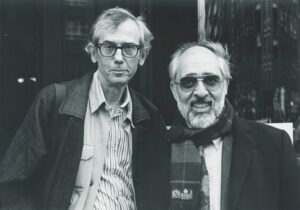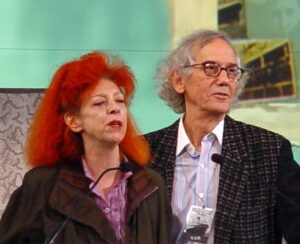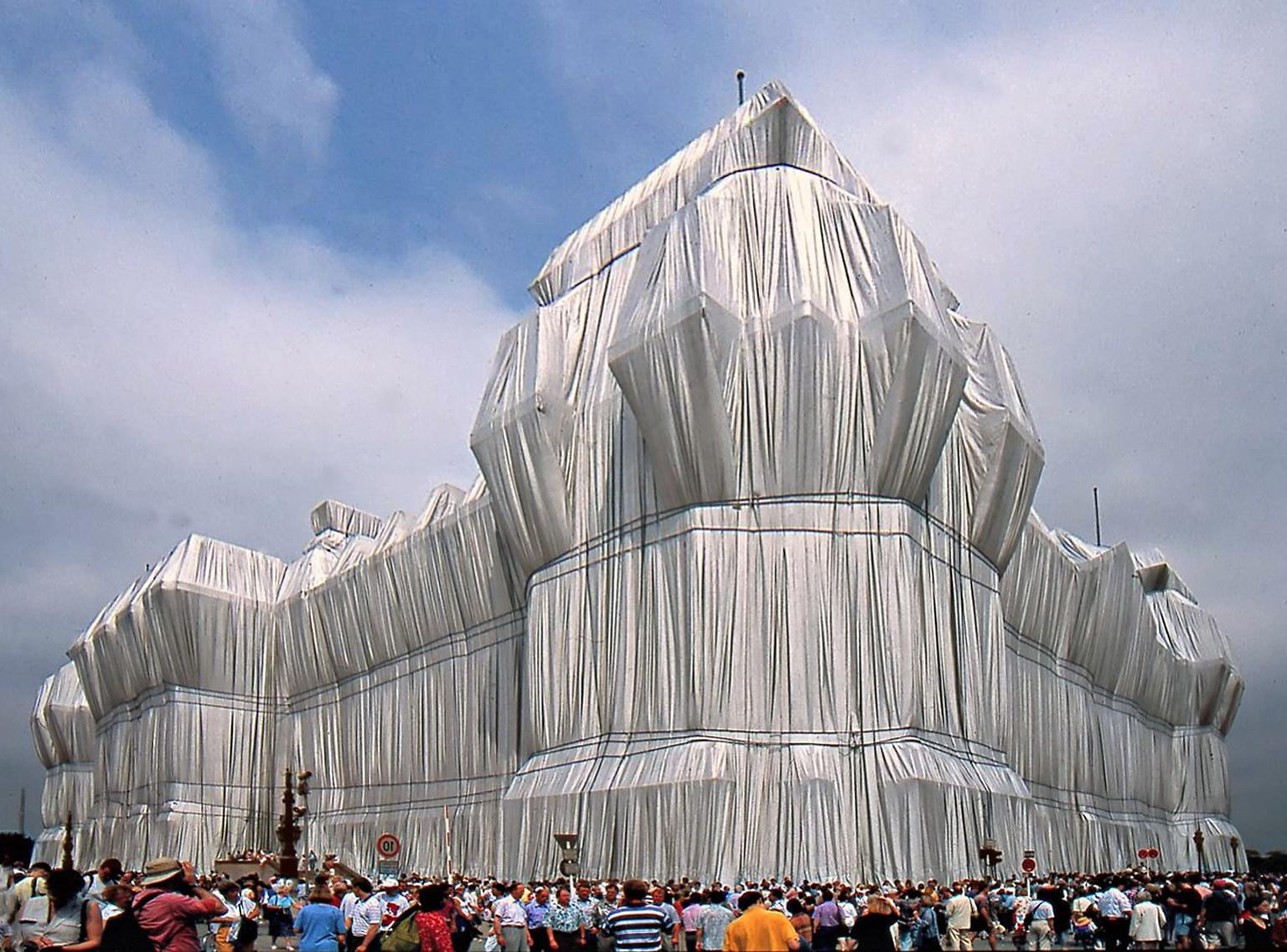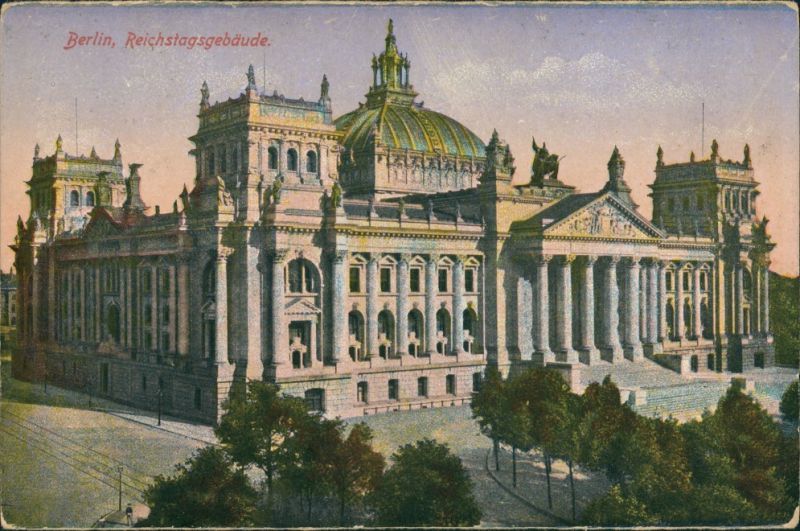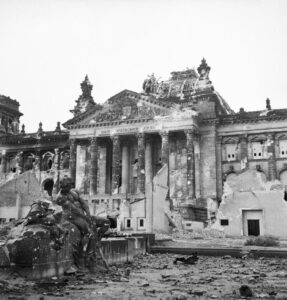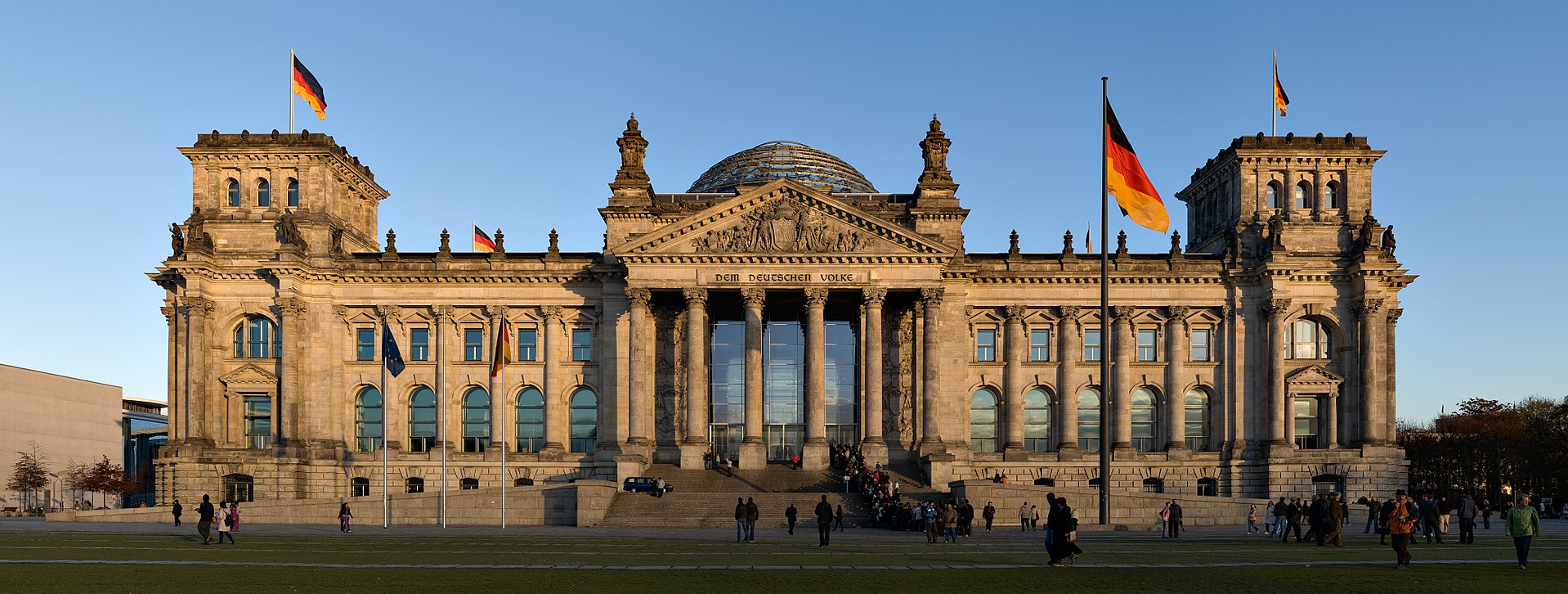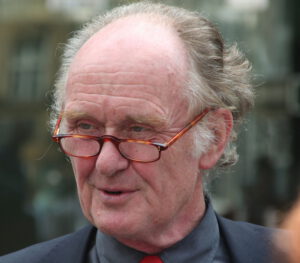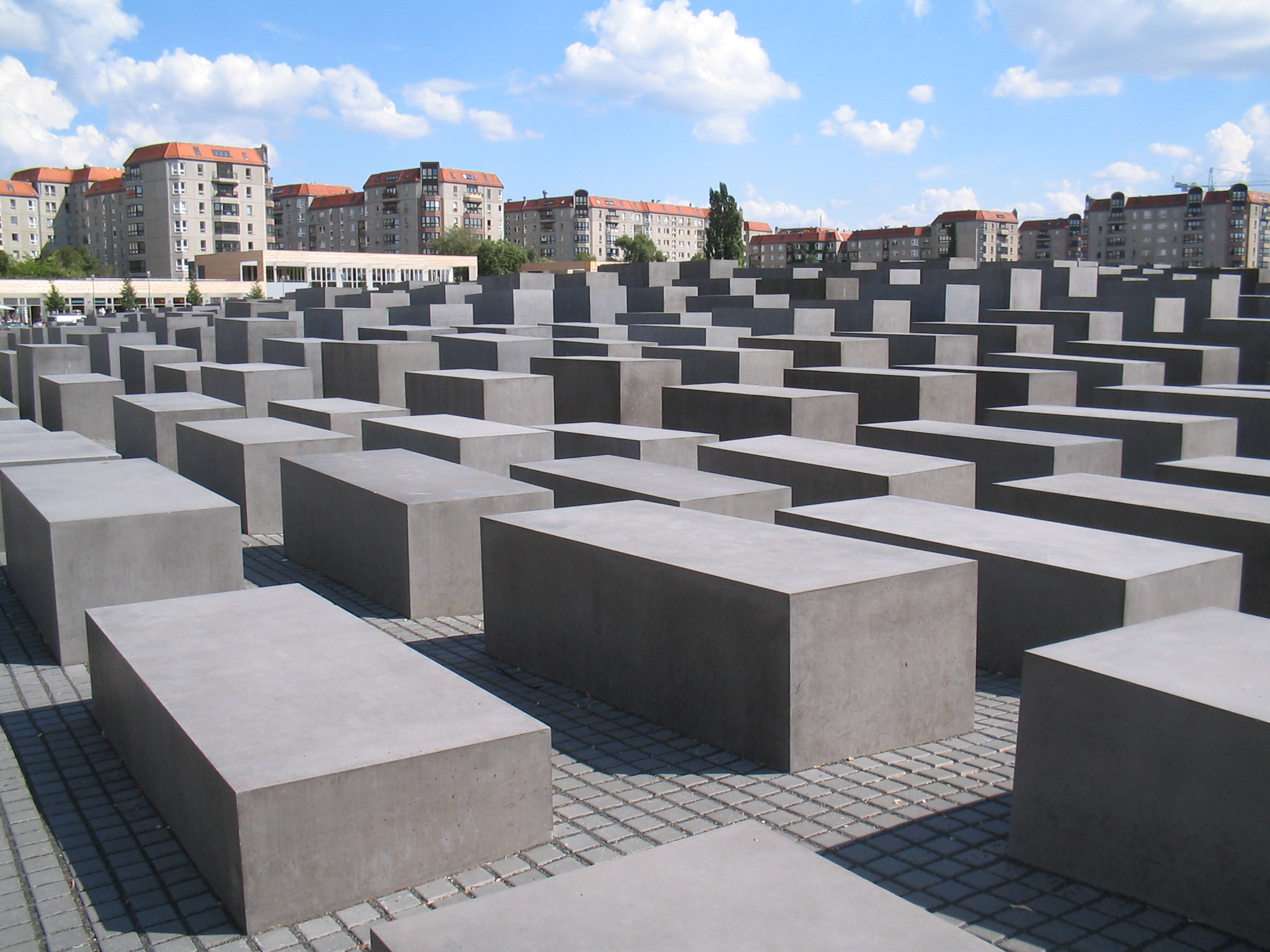Christo and Michael S. Cullen in Front of the Paris Bar, Berlin, 12 Dec. 1993, © M. Cullen 1 Now crowned with a glass dome by
Norman Foster meant to evoke parliamentary transparency, the building was more of an enigma in the 1970s, hazy in its symbolism and purpose. It had survived arson, war, occupation, halfhearted demolition attempts, and partial renovations that left the political future of the structure open (
Der Reichstag 278). Berlin was a divided city, and the massive structure was right on the border, just in the west, where it seemed to embody all the contradictions of the Cold War. Since the seat of the West German government was in Bonn, the Reichstag was neither needed nor authorized for parliamentary purposes. When Michael Cullen sent Christo a postcard encouraging him to wrap the building, most people seemed inclined to simply ignore it.
2 Cullen owned a Berlin art gallery at the time—the Galerie Mikro, which was known for hosting exhibits by artists like
David Hockney and
Jim Dine , small concerts, and once a poetry reading by
W. H. Auden (
Berliner Zimmer 156). A visit to
dokumenta IV in Kassel in 1968 had acquainted Cullen with
Christo and Jeanne-Claude ’s enormous, inflatable installation piece, “5,600 Cubic Meter Package” (
Berliner Zimmer 154). He was also intrigued by the efforts of a curator in Hanover to take art from the museums into the streets (“Kunst auf der Straße”). When in 1971 a friend flew to Colorado to help film Christo and Jeanne-Claude’s “Valley Curtain,” Cullen had a “Schnapsidee,” a crackpot idea, and asked him to deliver a postcard. It featured the Reichstag on its face along with a note on the back asking the artist-pair to wrap the building on the other side (
Berliner Zimmer 157-58). The idea took root. Before the year was up, Cullen met with Jeanne-Claude in New York and with Christo and Jeanne-Claude in Zurich, and with their blessing began laying the groundwork for a project that would take 24 years to realize (
Der Reichstag 281 ff.).
Christo and Jeanne-Claude, 19 April 2005, Photo by Martin Dürrschnabel , CC BY-SA 2.5 3 The “Wrapped Reichstag” was born in a dialogue spanning the Atlantic. It is so true to the spirit of Christo and Jeanne-Claude’s work that it fits seamlessly into their oeuvre. Some even consider it their most spectacular project. However, it also expresses the career trajectory of Cullen, whose extensive research into the forgotten history of the Reichstag has made him the building’s conscience. When this memorial remembers (“Was denkt das Denkmal?”), it does so in the voice of an American gallerist who has made his home in Berlin. Cullen is not famous, but the role he played in the internationalization of the Berlin art scene during the Cold War helped lay the groundwork for a significant transformation in public memory after the fall of the Wall. History is national, but memory in Berlin has become cosmopolitan, bringing together a plurality of voices that complicates the national framing of traditional historical narratives.
4 As a teenager Cullen was fascinated by the construction of the
Verrazzano-Narrows Bridge between Staten Island and Brooklyn; later he became a kind of bridge-builder himself. He studied Russian in college, accepted a job with Radio Liberty in Munich after graduating, and following a semester of graduate school at Columbia University, returned to Germany, where he first taught English in Hanover before moving to Berlin to teach there. In the 1960s he did not have a definite career plan. However, the vagaries of the Berlin housing market provided him with a series of large apartments, one of them a former bakery. He decided to fill the empty space with art in order to fill it with people. This would remain his exhibition strategy for the next decades. Cullen hangs art on walls in order to transform spaces into events. His impulse is a double one: he uses art to repurpose under-utilized space, and he uses space to democratize art. The effect is dialogic, pushing art—and conversations about art—into the public sphere.
5 Cullen got his start showing art rather than writing history, but his career demonstrates how the two come together in contemporary memorial architecture. When he hosted the first press conference with Christo (Jeanne-Claude was not present) on February 11, 1976 in his gallery/apartment, the proposal to wrap the Reichstag generated the kind of excitement Cullen was after, but it also encountered official resistance (
Berliner Zimmer 158). Those opposed to the project claimed that wrapping it would damage the sanctity of the building. Christo, who saw drapery as a sign of respect, asked Cullen to find out something they might use by way of counterargument. After several years of intensive research, Cullen produced a book,
Der Reichstag , which has gone through five editions and is still considered the authoritative history of the building. The 1999 edition, which I refer to here, was published to commemorate the relocation of the German parliament into the building rededicated to it use. It bears a foreword by
Wolfgang Thierse , President of the Bundestage at the time, praising the author for his work in helping to bring both the building and parliamentary procedure to life: “Nicht nur dieses Bauwerk, sondern der Parlamentarismus ingesamt wird uns dadurch in Geschichte und Gegenwart lebendig” (9). The line Thierse draws between the past and the present is significant. What Cullen’s work brings to life is the many people involved in the project, from public officials and architects to stone masons and painters, extending from the first building commission to the construction of Foster’s glass dome. His book stresses, again and again, that a multitude of people were involved in building a structure which was intended to house a parliamentary body charged with representing them.
Wrapped Reichstag, Wrapped Reichstag Project Berlin 1995, Photo by txmx2 , CC-BY-NC-ND-2.0 6 The Reichstag, it turns out, has always been wrapped in dialogue. It has consistently provoked the kind of debate it is supposed to house. Cullen recovers voices from history in order to show how they are connected to voices in the present through a structure whose fate has marked decisive turning points in German history. Cullen undertook the building history to advocate Christo’s project, but his monumental book is more than a
Plädoyer ; it achieves in narrative form what wrapping the monument achieved as an event. The five million visitors to the Wrapped Reichstag between 27 June and 7 July 1995 became participants in an ongoing dialogue occasioned by the veiling (
Reichstag 287). The event assembled the people the Reichstag is supposed to represent as an assembly, constituting them as “the people/dem Volk” by reconnecting them with parts of German history that had been partly concealed from view. As Cullen has discovered throughout his career, hanging art in—or on—under-utilized spaces encourages debate and discussion. Such debate and discussion is the business of a parliament, and the aim of the kind of memorial architecture meant to encourage democratic participation. Memories have to be collect
ed before they are collect
ive .
7 I asked Michael Cullen about the meaning of the Reichstag and other memorials during our interview. I include a partial transcript of his response, condensed for readability, for the light it sheds on what memorials remember/”was denkt das Denkmal”:
The Reichstag 1914, Color Postcard, Public Domain Ruins of the Reichstag, 3 June 1945, Photo by Sergeant C. H. Hewitt , No. 5 Army Film & Photographic Unit, BU8573, Imperial War Museums, Public Domain The Reichstag Building, 4 Nov. 2007, Photo by Jürgen Matern , CC BY-SA 3.0 8 It’s true that Reichstag was not looked at much before Christo wrapped it.
Robert Musil once said that the most important thing about monuments is most people look through them and don’t care who or what they are about. [“Das Auffallendste an Denkmälern ist, dass man sie nicht bemerkt. . . . Denkmäler scheinen gegen Aufmerksamkeit imprägniert zu sein.”] People forget things. Memories are stratified with new memories layered on top of old ones…Christo had learned from experience and instinct that wrapping something—or covering it up—makes people curious. People want to know what‘s behind that curtain, just like in
The Wizard of Oz .
9 [After delays in getting the project started] in 1993-94 we were helped by Heribert Scharrenbroich, a longtime member of the Bundestag and a devout Catholic. He was amazed that people saw wrapping the Reichstag as a sign of disrespect. Catholics wrap or veil the figure of Christ in the churches in the week before Easter to heighten the mystery of divinity. Christo, he said, wants to do the same thing for the Reichstag. Wrapping it will create much more attention for it than the building not wrapped.
Heribert Scharrenbroich in 2006, Photo by Thomas Schwarz , CC BY-SA 4.0 10 The Reichstag had long been disregarded. People never wanted it to begin with; they didn’t like it after it had been built; and when it was torched in 1933, many said “serves it right.” It was as if the Reichstag had set fire to itself, committed suicide even. After the war, it was partly in ruins. It had been additionally damaged by Red Army shelling and capture in 1945, and starting in 1958 the building was partly renovated and again in 1961 after a competition. It was used, but not for parliamentary purposes. It was in the way.
11 I wanted it wrapped because I wanted attention to be paid to it. People said it would never be used unless Germany reunified, and at that point I didn’t see reunification in the cards. I thought of the Reichstag as a huge pile of sandstone full of art I didn’t much care about. I wanted people to talk about it—if it couldn’t be used as a parliament, it should be used for something else. Christo was interested in other things. He was interested in the folds, the drapery, how it would look. He always said that he was not political, but I always argued that he was.
12 We used to argue about this gently until his death a few months ago. I said you must have known a lot about it because a
landsmann [countryman] of yours,
Georgi Dmitrov was accused of setting fire to it. He was later acquitted and after WWII made president of Bulgaria. I can’t imagine any school in Bulgaria without his photo hanging on the wall; streets must be named after him. Christo said no, he didn’t want to wrap the Reichstag to make a political point. We disagreed about this until he died. Now I have last word.
13 I also wanted to give people a chance to encounter art outside the museum. Many people are afraid of visiting an art museum. They are afraid to feel stupid because they can’t explain why a famous painting is meaningful, why the subject is wearing a red coat or why the foot is pointing in a particular direction. In Hanover in 1970–71, a museum curator moved some of the most important works into the streets and got people finally to look at art. Art has a “bum rap.” People think they have to know about it to appreciate it . . . . For Christo art history was beside the point. We wanted to move art into the streets. . . . When people find out why a monument was made they get excited.
14 Many art historians talk about who built what but not about ALL the other people who are involved with large projects like the Reichstag. They start with the architect and don’t think about who commissioned him and why they want a building done for a particular reason. I want to know the reasons. I also want to know who is for it and who is against it. And I want to know who pays for it. Those are the public discussions—the most interesting part for me. You can say you love a particular set of columns, sculptures, painting, or whatever, but I’m interested in saying why the architect did what he did and whom is he trying to please. That’s where I break ranks with art historians. They go straight from artist’s intentions and not from the intentions of who commissioned the building . . . . But the history of monuments teaches us much more about people and societies that commissioned them than the people and events for whom they were commissioned. . . . Every monument has a crazy story. The Kaiser shouldn’t have had anything to say about the Reichstag but he did. He used his unsharp pencil to make notes on the architectural drawings, and when the architect told his majesty that he couldn’t do that, the Kaiser was miffed . . . . All monuments in Berlin have a story. I could spend the rest of my life telling these stories.
15 Cullen has a wealth of stories to share. He mentioned the 10-year long debate about what
Frederick the Great should wear in the equestrian statue by
Christian Daniel Rauch that stands on
Unter den Linden , the famous boulevard in the center of Berlin. He also brought up a similar debate about
Horatio Greenough ’s sculpture of a bare-chested George Washington that was been banned from the rotunda of the United States Capitol building because veterans objected that nobody had ever seen him without his shirt on. Finally, he mentioned the Heinrich-Heine-Denkmal, sculpted by
Ernst Herter , that was supposed to be unveiled at the poet’s 100
th birthday in his native Düsseldorf but wound up, the victim of anti-Semitic agitation, at the Bronx Zoo instead.
16 These stories help explain how modern commemoration differs from more classical efforts of putting a leader on a horse, or in classical garb, or Lorelei on a pedestal. Such sculptures are erected in open places where spectators can gather round on anniversaries, throw bouquets, and then forget about remembering for the rest of year. New commemorative efforts are unconventional and sometimes, like an installation piece, transient, but they seek to involve viewers in a dialogue that extends beyond the physical presence of the memorial. They are not symbols of the past so much as attempts to create a bridge between the past and the future—often the nationalistic past and more cosmopolitan future.
Holocaust Memorial Berlin 2006, Photo by K. Weisser , 17 A more permanent example of this dialogic approach is the Memorial to the Murdered Jews of Europe, designed by
Peter Eisenman , erected within sight of the Reichstag, and unveiled in 2005. Everything about this memorial was heavily debated: the concept, the purpose, the design, the location. Michael Cullen, by then a widely recognized expert on Berlin monuments, was involved. He edited a volume of some of the most important contributions to the debate, pro and con:
Das Holocaust-Mahnmal: Dokumentation einer Debatte . In his introduction he mentions James Young, an American expert on memorials who served on the search committee responsible for selecting the design. Young, in his contribution to the third colloquium in April 1997, recommended a calmer approach to this subject and stressed that the discussion was an indispensable part of a memorial (18). This has always been Cullen’s opinion, and it is characteristic of his belief in dialogue that he would quote someone else as saying it. He initially expressed reservations about the Eisenman design, but after fifteen years, he is getting used to it. Characteristic for someone who has spent his career undergirding art with archival research, his favorite part is the subterranean documentation center, added as an afterthought and designed to keep people talking (see Gross, “Holocaust Tourism in Berlin”).
18 Art, for Cullen, has always been an occasion for talking, but only after it has been freed from the discursive and architectural structures that repress dialogue in the name of authoritative interpretations. Taking art out of museums, into what we would today call pop-up galleries and into the streets, is one way to combat the authority of expert opinion. However, some art closes itself off in its own structures of authority and expertise. Classical memorials, with their official relation to history, are examples of this tendency. Cullen had the idea to veil the Reichstag because he likes to hang art on unused walls. However, he also sensed that the veil would materialize the restrictive, authoritative interpretations that have limited the meaning of memorials, and the Reichstag in particular. He sensed that the ephemerality of veiling could act as an impetus to future dialogue.
19 After 24 years of effort, the Wrapped Reichstag proved the value of the approach. We remember Christo and Jeanne-Claude for conceptualizing the project, financing it through sales of their art, and investing their artistic energy into the material, the folds, the frame that had to hold up the heavy veil without damaging the Reichstag. We should also remember that Michael Cullen came up with the initial idea. He thought art had a “bum rap,” a colloquial expression referring to the “rap sheets” or lists of crimes that police assemble about criminals. “Rap” is also a homophone for “wrap.” Thanks to Cullen, one building’s bad rap could be addressed through a good wrap.
Public memory in Berlin is still enveloped in its folds.
Gross, Andrew. “‘Art Has a Bad (W)rap’: A Conversation with Michael Cullen about the ‘Wrapped Reichstag’.” American Studies Journal 69 (2020). Web. 27 Jul. 2024. DOI 10.18422/69-05.
